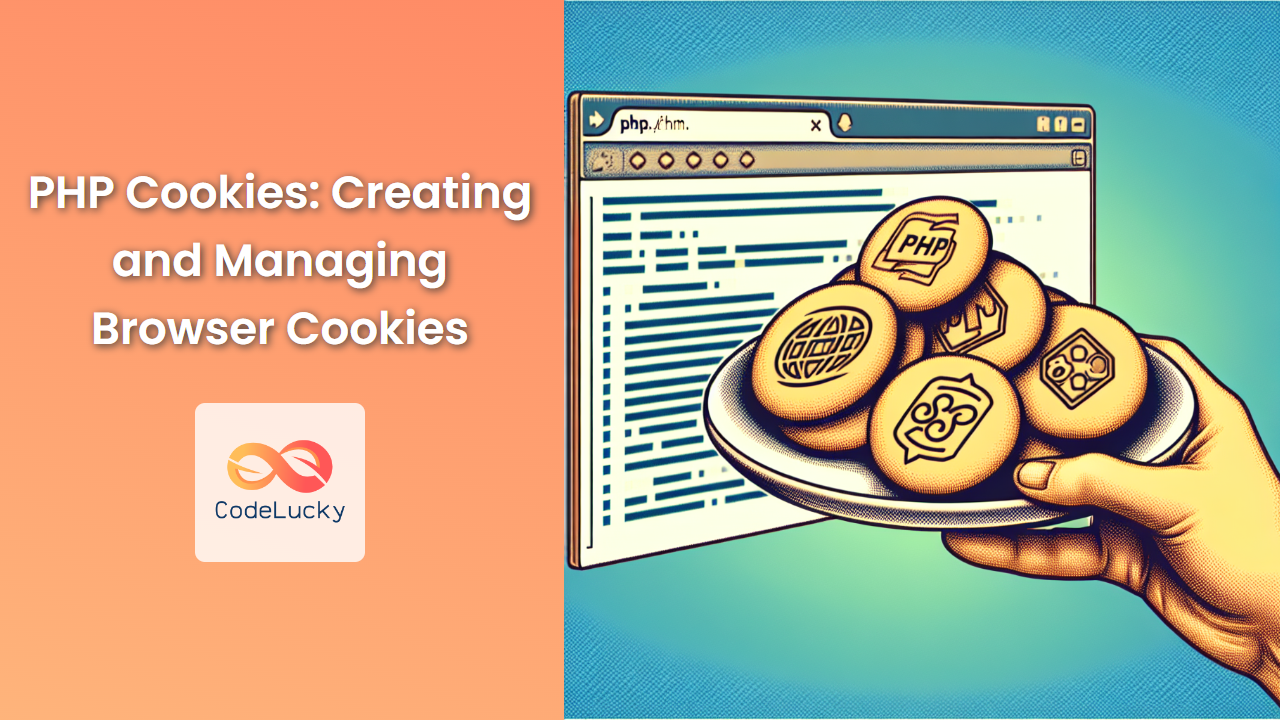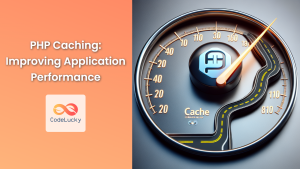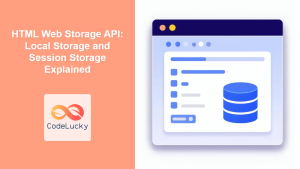In the world of web development, cookies play a crucial role in enhancing user experience and maintaining state information. As a PHP developer, understanding how to create, manage, and utilize cookies is essential for building robust and user-friendly web applications. In this comprehensive guide, we’ll dive deep into the world of PHP cookies, exploring their creation, manipulation, and best practices.
What are Cookies? 🍪
Before we delve into the PHP specifics, let’s briefly discuss what cookies are. Cookies are small pieces of data stored on the client’s browser. They’re used to remember information about the user, such as login status, preferences, or shopping cart contents. Cookies are sent with every HTTP request to the server, allowing the server to recognize and respond to the client appropriately.
Creating Cookies in PHP
PHP makes it easy to create cookies using the setcookie() function. Let’s look at the basic syntax and then explore some practical examples.
Basic Syntax
setcookie(name, value, expire, path, domain, secure, httponly);
name: The name of the cookie (required)value: The value of the cookie (optional)expire: The expiration time of the cookie (optional)path: The path on the server where the cookie will be available (optional)domain: The domain that the cookie is available to (optional)secure: Indicates if the cookie should only be transmitted over a secure HTTPS connection (optional)httponly: When set to true, the cookie will be accessible only through the HTTP protocol (optional)
Now, let’s create our first cookie!
<?php
setcookie("user", "John Doe", time() + 3600, "/", "", true, true);
?>
In this example, we’ve created a cookie named “user” with the value “John Doe”. The cookie will expire in one hour (3600 seconds from now), is available for the entire website (“/”), and is set to be secure and HTTP only.
🔍 Note: The setcookie() function must be called before any output is sent to the browser. This is because cookies are part of the HTTP header, which must be sent before the actual content.
Reading Cookies in PHP
Reading cookies in PHP is straightforward. We use the $_COOKIE superglobal array to access cookie values. Let’s see an example:
<?php
if(isset($_COOKIE['user'])) {
echo "Welcome back, " . htmlspecialchars($_COOKIE['user']) . "!";
} else {
echo "Welcome, guest!";
}
?>
This script checks if the ‘user’ cookie is set. If it is, it greets the user by name. Otherwise, it displays a generic welcome message.
🛡️ Security Tip: Always use htmlspecialchars() when outputting cookie values to prevent XSS attacks.
Modifying Cookies
To modify an existing cookie, you simply need to set it again with the new value. PHP will overwrite the old cookie with the new one.
<?php
// Original cookie
setcookie("user", "John Doe", time() + 3600, "/");
// Modifying the cookie
setcookie("user", "Jane Smith", time() + 3600, "/");
?>
In this example, we first set a cookie for “John Doe”, then immediately overwrite it with “Jane Smith”.
Deleting Cookies
To delete a cookie, you need to set its expiration time to a time in the past. Here’s how you can do it:
<?php
setcookie("user", "", time() - 3600, "/");
?>
By setting the expiration time to one hour in the past, we ensure that the browser will delete the cookie immediately.
Working with Multiple Cookies
In real-world applications, you’ll often need to work with multiple cookies. Let’s look at a more complex example where we manage a user’s preferences:
<?php
// Setting multiple cookies
setcookie("theme", "dark", time() + 86400 * 30, "/");
setcookie("font_size", "16px", time() + 86400 * 30, "/");
setcookie("language", "en", time() + 86400 * 30, "/");
// Reading multiple cookies
if(isset($_COOKIE['theme']) && isset($_COOKIE['font_size']) && isset($_COOKIE['language'])) {
echo "Your preferences:<br>";
echo "Theme: " . htmlspecialchars($_COOKIE['theme']) . "<br>";
echo "Font Size: " . htmlspecialchars($_COOKIE['font_size']) . "<br>";
echo "Language: " . htmlspecialchars($_COOKIE['language']) . "<br>";
} else {
echo "Please set your preferences.";
}
?>
In this example, we’re setting three cookies for user preferences and then reading them back. This could be used to personalize a user’s experience on your website.
Cookie Arrays
PHP also allows you to create array cookies. This is useful when you want to store multiple related values in a single cookie. Here’s how you can do it:
<?php
// Setting an array cookie
setcookie("cart[1]", "Item 1", time() + 3600, "/");
setcookie("cart[2]", "Item 2", time() + 3600, "/");
setcookie("cart[3]", "Item 3", time() + 3600, "/");
// Reading an array cookie
if(isset($_COOKIE['cart'])) {
echo "Your cart contains:<br>";
foreach($_COOKIE['cart'] as $key => $item) {
echo htmlspecialchars($key) . ": " . htmlspecialchars($item) . "<br>";
}
} else {
echo "Your cart is empty.";
}
?>
This script creates a ‘cart’ cookie that contains multiple items. When reading the cookie, we can iterate over its contents like a regular array.
Best Practices for Using Cookies in PHP
-
Security First: Always use the
httponlyandsecureflags when setting cookies to enhance security. -
Expiration Time: Set an appropriate expiration time for your cookies. Don’t make them last longer than necessary.
-
Data Minimization: Store only the necessary information in cookies. Sensitive data should never be stored in cookies.
-
Encryption: If you must store sensitive data, consider encrypting it before setting the cookie.
-
Validation: Always validate and sanitize cookie data before using it in your application.
-
GDPR Compliance: If your website targets EU users, ensure your cookie usage complies with GDPR regulations.
Practical Example: Remember Me Functionality
Let’s put our knowledge to use by creating a “Remember Me” functionality for a login system:
<?php
session_start();
// Function to set a remember-me cookie
function setRememberMeCookie($username) {
$token = bin2hex(random_bytes(16)); // Generate a random token
setcookie("remember_me", $username . ':' . $token, time() + 86400 * 30, "/", "", true, true);
// In a real application, you would store this token in your database
// associated with the user for verification later
}
// Function to check the remember-me cookie
function checkRememberMeCookie() {
if(isset($_COOKIE['remember_me'])) {
list($username, $token) = explode(':', $_COOKIE['remember_me']);
// In a real application, you would verify this token against your database
// For this example, we'll just assume it's valid
$_SESSION['user'] = $username;
return true;
}
return false;
}
// Simulated login process
if($_SERVER['REQUEST_METHOD'] == 'POST') {
$username = $_POST['username'];
$password = $_POST['password'];
$remember = isset($_POST['remember']);
// In a real application, you would verify the username and password here
// For this example, we'll just assume they're correct
$_SESSION['user'] = $username;
if($remember) {
setRememberMeCookie($username);
}
header("Location: welcome.php");
exit();
}
// Check if user is already logged in
if(!isset($_SESSION['user'])) {
if(!checkRememberMeCookie()) {
// If not logged in and no valid remember-me cookie, show login form
?>
<form method="post">
Username: <input type="text" name="username"><br>
Password: <input type="password" name="password"><br>
<input type="checkbox" name="remember"> Remember Me<br>
<input type="submit" value="Login">
</form>
<?php
} else {
// If remember-me cookie is valid, redirect to welcome page
header("Location: welcome.php");
exit();
}
} else {
// If already logged in, redirect to welcome page
header("Location: welcome.php");
exit();
}
?>
This example demonstrates a basic implementation of a “Remember Me” functionality using cookies. It includes:
- A function to set a remember-me cookie with a random token
- A function to check the remember-me cookie
- A simulated login process that sets the cookie if the “Remember Me” option is selected
- A check for an existing session or valid remember-me cookie
Remember, this is a simplified example. In a real-world application, you would need to implement proper security measures, such as securely storing and verifying the remember-me token in your database.
Conclusion
Cookies are a powerful tool in a PHP developer’s arsenal, allowing for the creation of more personalized and user-friendly web applications. By mastering the creation, reading, and management of cookies, you can enhance user experiences and build more sophisticated web applications.
Remember to always prioritize security when working with cookies, especially when dealing with sensitive user data. With the knowledge gained from this guide, you’re now well-equipped to implement cookie-based features in your PHP applications.
Happy coding, and may your cookies always be fresh and secure! 🍪💻



















